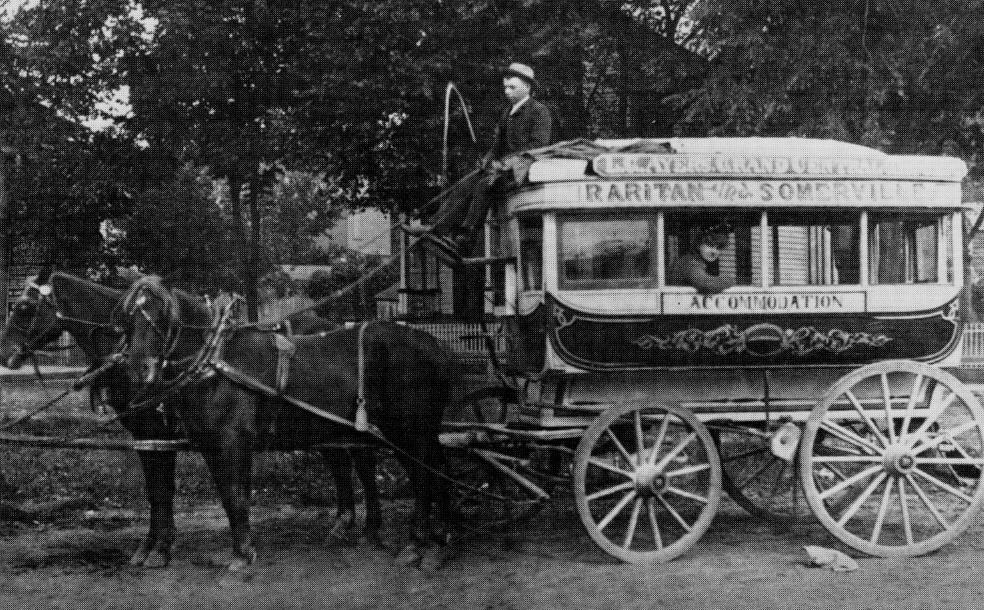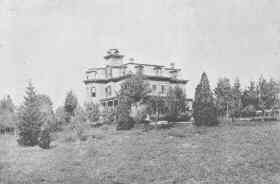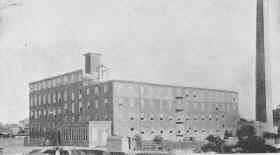Raritan in 1891

The first source is a short booklet from 1891 entitled Illustrated Somerville and Raritan. This has a description of Raritan as well as 10 of the oldest known photos of Raritan.
Another source is the local weekly newspaper The Unionist Gazette which is available on microfilm at the Bridgewater Library.
Lastly, a surviving detailed map from that time shows almost all the buildings and roads in town.
One of these factories had an exhaust pipe that was 140 feet tall and 25 feet wide. This served as the landmark for Raritan as it was visible for miles around.
Somerville Water Company complex.

The town was considered clean by the standards of the day. Efforts were made to keep the unpaved roads clean and passable. In the wet weather mud was removed.
The town of Raritan was linked commercially and socially with its larger, older neighbor Somerville. Some entertainment and specialty businesses were only available in Somerville.
still stands today

Raritan resident John Frech owned a stage coach that made trips twice an hour. The fare from one town to the next was six cents.

For at Somerville another train line, now abandoned, would go to Flemington. Also, at Bound Brook another now defunct train line could take you to Philadelphia.

The telephone, another recent invention, was in its infancy with just a few in use. A telephone directory from that decade shows ten phones in Raritan. The Frelinghuysen Mansion (located where the PC Richard is today) was the only personal residence that had a phone. The other phones belonged to the Raritan Fire Department, and the factory businesses all had phones. There was one pay phone in town inside a jewelry store.
the only home with a telephone.

This would be necessary as just two year later, in 1893, electricity would start coming into their homes.

Also along the river was the Somerville Water Company which supplied water to the surrounding area. The Adair Flour Mill stood where the stone castle is today. On First Avenue, in a long red brick building that still stands today (next to Delucia Pizza), was The American Farm Implementation Company who made farm equipment.
burnt down in the 1950s.

One popular celebration by the churches, that is no longer held today, was Childrens Day which was held the second week in June to honor children.

A band from Raritan, the Crescent Cornet Band, often played at various events in town and sometimes just played right out on the street on an ordinary day. They were greatly appreciated by the Raritan residents. The band even encouraged people to attend their rehearsals. The Crescent Cornet Band was in demand and often traveled to play in other towns in New Jersey.

Also, the first police force for Raritan was formed in 1891. One officer would patrol the day and two would patrol the more devious night time. The train station depot which survives to today was built in 1891.

The old buildings were in such bad shape that they were considered to be a poor representation of a good town such as Raritan. As result what we today call the Historic Firehouse on Anderson Street would be completed the next year.

Horse drawn wagons delivering goods or selling goods were common in town. One novel business of its era was Gallagher and Richards Ice that provided blocks of ice for the ice boxes in the homes.
They had their own ice pond which fed off the canal. The only power source available to turn water into ice in those days was Mother Nature. Ice made in the winter was stored as best they could and for as long as they could for delivery in later warmer months.

For fun, tennis had just become widely popular. There was a Raritan Lawn Tennis Club that had built several tennis courts.
Baseball was also popular, there were a few baseball fields scattered around town. There was a Raritan Gun Club that had a shooting range next to the railroad tracks.

Traveling circuses often visited the area. While they were always held in Somerville, the initial teaser parades that the circuses held to promote themselves would start in Raritan and go down the main street. Another popular entertainment show, shamefully the most popular type of the era, was the minstrel show featuring singers and dancers in blackface.
was knocked down 10 years ago.